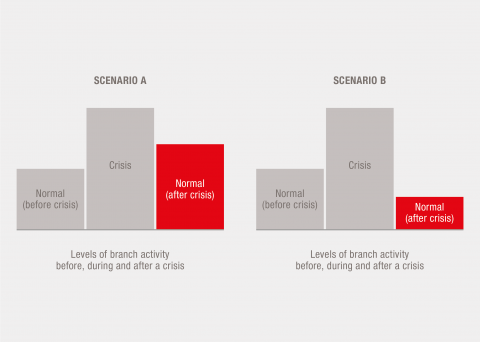The competences required to perform well in a crisis are the result of preparation. They come from having the right people, resources, relationships and organisation.
Crisis can be the time for a branch to grow, as shown in scenario A below. Here, the branch has increased its capabilities through the experience of the operation and has been able to increase its normal level of activity. But if a branch becomes weaker and not stronger as a result of a crisis, as shown in Scenario B, then something has gone wrong.

Both the scaling up of service delivery during a response and the scaling down that follows a response are challenging situations and can cause harm to the long-term sustainability of the branch. There are cases where outside support (technical, financial, goods), especially large inputs in crisis situations, have left National Societies and branches with structures and systems that are unsustainable.
Such situations arise from:
* Support that is not integrated into the culture and systems of the National Society and the branch
* Changes that alienate volunteers and employees or undermine a branch's resource base
* Changes in ways of working that alienate local supporters and partners
* Actions by outsiders that harm the image of the branch and impact its reputations for many years.
On the other hand, when National Societies and branches actively manage external support, crisis becomes an opportunity for growth.
We the Movement partners are part of the problem. We use volunteers while not doing volunteer work. ...
more
We the Movement partners are part of the problem. We use volunteers while not doing volunteer work. They are loading and unloading materials for a full day. This should be paid work. There needs to be a common policy between partners on what volunteers receive in per diems.
Gori Branch of the Georgia Red Cross traces its history back to 1918 when the branch managed a local...
more
Gori Branch of the Georgia Red Cross traces its history back to 1918 when the branch managed a local health clinic. Ninety years later, branch volunteers were the first responders to meet the needs of internally displaced people during the 2008 conflict between Georgia and Russia over the breakaway territory of South Ossetia. Building on this experience, the branch has since partnered with communities and local actors, as well as Movement supporters, to provide continued support to those displaced and to other vulnerable groups.
There is a conflict. We have the sole mandate to be present. So a large responsibility for the branc...
more
There is a conflict. We have the sole mandate to be present. So a large responsibility for the branch. We are the true model of being auxiliary to the government and working 24/7 under the eyes of everyone there. So we need to show that leadership is strong. We are still in the process of developing the branch’s capacity. We have moved from 20 volunteers to more than 250 volunteers in 1.5 years. This is an indicator that the branch is working effectively with the community. We have used the number of volunteers as one of the indicators to show that working in the right direction. We started on different levels. Developed the capacity of the staff, volunteer management. And to strengthen volunteer friendly spaces.